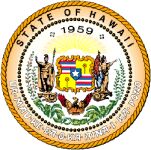|
||
 |
||
|
Hawaii,
the "Aloha State"
Abbreviation: HI |
||
|
The name Hawaii is believed
to be an English adaptation of the native word for "homeland"
(hawaiki or owhyhee). First settled by Polynesians sailing
from other Pacific islands between A.D. 300 and 600, Hawaii was visited
in 1778 by British Captain James Cook, who called the group the Sandwich
Islands. Following its annexation in 1898, Hawaii became a U.S. territory
in 1900. Hawaii is the youngest state, joining the Union in 1959 as
the 50th state, just after Alaska. Hawaii is world famous for its pleasant
climate and spectacular beauty. It has deep-blue seas, brilliantly colored
flowers, graceful palm trees, magnificent waterfalls and dramatic volcanoes.
Hawaii consists of a chain of 132 islands; the eight main islands are
at the southeastern end of the chain. Hawaii, the "Aloha State"
has many customs originating from the original Polynesian settlers. GOVERNMENT
Population (July 2001): 1,227,024; National Rank: 42; Percent change since April 2000: 1.1% Land Area: 6,423 sq mi. (16,637 sq km); National Rank: 43 10 largest cities (2000): Honolulu, 371,657; Hilo, 40,759; Kailua, 36,513; Kaneohe, 34,970; Waipahu, 33,108; Pearl City, 30,976; Waimalu, 29,371; Mililani Town, 28,608; Kahului, 20,146; Kihei, 16,749 ECONOMY |
||
|
DISCLAIMER Any reference obtained from this server to a specific commercial product, process, or service does not constitute or imply an endorsement by the United States Government of the product, process, or service, or its producer or provider. The views and opinions expressed in any referenced document do not necessarily state or reflect those of the United States Government. |
|
U.S. Diplomatic Mission to Germany
/Public Affairs/ Information Resource Centers Updated: June 2003 |

